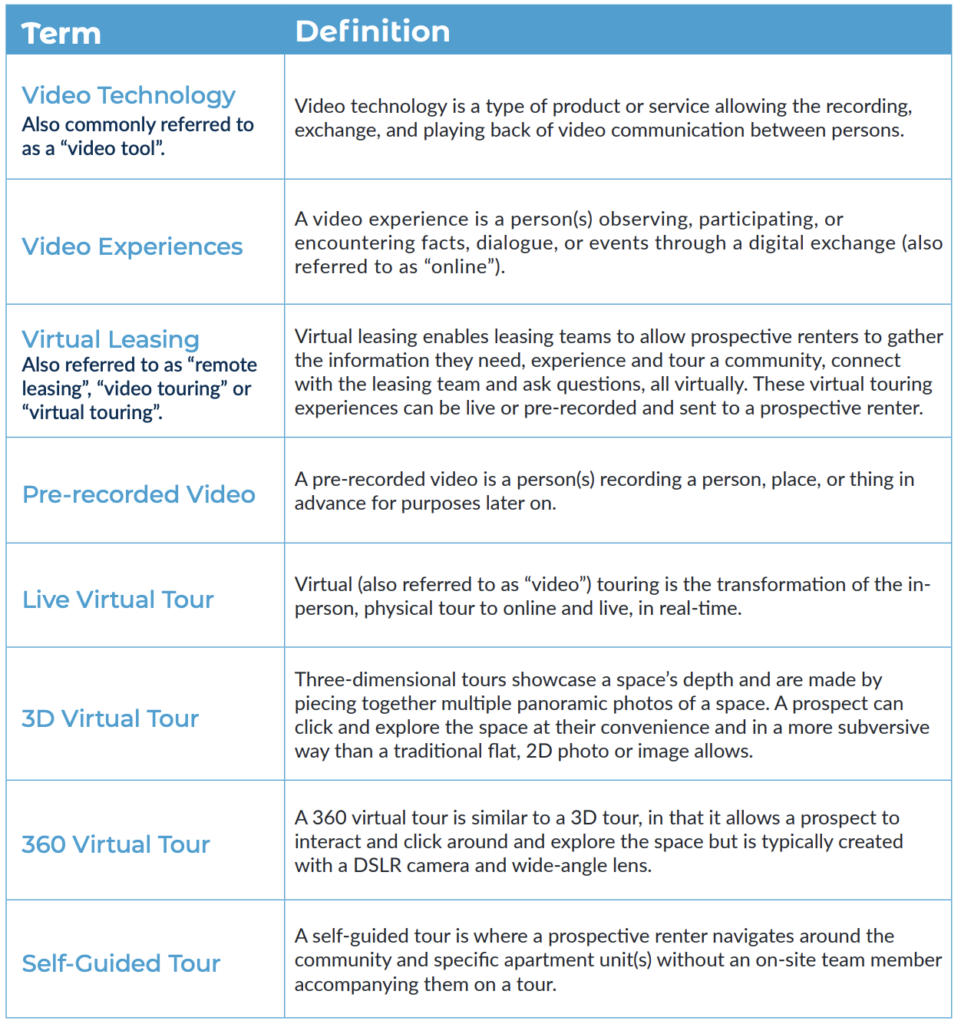Recently, apartments.com launched the “Listing of the Future™” where they encourage unit-level content — virtual tours, videos, and photos. It can be a challenge to create unit-level video content if you aren’t sure where to start or if you don’t have the proper equipment.
Now, it may also be a challenge for some to create unit-level content who didn’t know there’s a difference between virtual tours, 3D tours, videos, and 360 tours. So, we address the differences between them all, the benefits of unit-level content creation, and how to create a unit-level video tour effectively below.
What Does Virtual Tour Mean?

*Above is Realync’s definition bank. As virtual tours continue to grow in multifamily and new technologies enter the space, we felt a responsibility to define and align on the different types of video software available today.
What’s The Benefit in Unit-Level Content Creation?
Unit-level content allows prospective renters to see the exact unit they’ll call home. By capturing virtual tours, video tours and photos, you’ll create a personalized, convenient and frictionless experience for renters. For years, the multifamily industry had only one touring option — in-person tours. Now, apartments.com and other property technologies solution are paving the way for multi-touring options, ultimately giving prospective renters what they want — options and convenience.
Kristi Fickert, VP of Enterprise Growth at Realync, hits on the benefits of unit-level content even deeper from a renter perspective and on-site leasing agent perspective.
“First, virtual tours save time for both prospect and leasing agent. A virtual tour average is anywhere from 14 to 18 minutes while a regular in-person tour averages around 45 minutes to an hour. Second, unit-level virtual tours drive interest. At the unit-level, virtual tours give prospects that deep in the weeds view of a particular unit they might be interested in which is going to spark even more curiosity. From this, it’s possible they’re going to request their own personalized tour or request an in-person tour now that they’ve seen the inside of this exact unit — curiosity inspires acts. From there, they’re more likely to convert!”
Kristi continued, “Lastly, the benefit of unit-level content is it’ll inspire prospective renters to ask questions, meaning contacting your team. This will help you gauge which layouts are most important to renters which can inform your marketing and leasing decisions. At the unit-level, prospects will see features and things specific to that unit that might not be shown on your website in just your general marketing videos and photos. Ultimately, this type of content will inspire engagement in conversation as well.”
How to Create a Unit-Level Virtual Tour
Already using video but want to learn how to create quality unit-level content quicker?
You’ll want to consider angles, lighting, equipment, and personalization when creating a unit-level virtual tour. Start by doing a practice run before you record, and walk slower than you think you should. Also, make sure you have the best lighting by opening the curtains. Here are a few other considerations:
- You want to ensure you have the right tools like a high-quality stabilizer or gimbal to keep videos steady.
- You don’t need a professional photographer if you have the right application on your phone.
- You’ll want to shoot videos in horizontal mode with a wide-angle lens attachment.
- You’ll want a WCAG-compliant and multifamily-specific video platform like Realync (why Zoom isn’t the answer!)
Now that you’re equipped with the knowledge on unit-level content creation, don’t forget to share your videos. Creating a video tour is not valuable without getting it out there in front of prospects. So, ensure you have a promotional plan built out (e.g., are you posting those videos on your website, social sites or apartments.com?).
